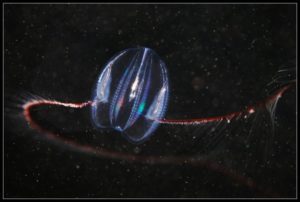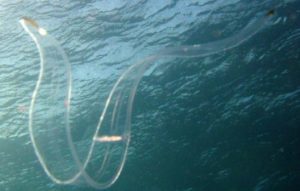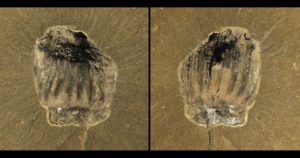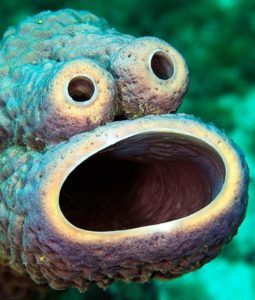Podcast: Play in new window | Download (Duration: 15:47 — 15.4MB)
We’re learning about comb jellies this week, along with the sea sponge, and the MASSIVE CONTROVERSY ABOUT THE TWO THAT IS PITTING SCIENTIST AGAINST SCIENTIST I might be overstating it just a bit
The lovely Arctic comb jelly:

The lovely Venus’s girdle comb jelly:

A fossil comb jelly. Probably lovely when it was alive:

A sea sponge (most are not this Muppet-like):

Show transcript:
Welcome to Strange Animals Podcast. I’m your host, Kate Shaw.
For this week’s episode, we’re revisiting jellyfish, more properly known as jellies. The first jelly episode is far and away our most popular and I can’t figure out why. I mean, I’m glad people like it. This time, we’re going to learn all about comb jellies, which are not really as exciting as true jellies. There is no ship-sinkingly enormous comb jelly lurking in the oceans of the world. But they are really interesting.
When you think of a jelly, you probably picture a roughly bell-shaped thing with long stinging tentacles. But most comb jellies are more like egg-shaped blobs, and either don’t have tentacles at all or only have relatively small tentacles that don’t sting. Although they look alike superficially, comb jellies and true jellies are so different that scientists don’t think they’re very closely related at all. Comb jellies are officially called ctenophores (TEN-oh-fours), spelled with a c-t at the beginning if you were wondering. I looked up the pronunciation. Yeah, I know, I pronounced Pliny wrong all through episode 12, but come on, it looks like it should be pronounced Pliny and not Plinny. It’s not like anyone ever came up to me and said, “Hey, what about that Plinny, what a guy.” I just read the name.
But I digress, inexplicably.
Instead of pulsing its bell to maneuver in the water, a comb jelly has rows of tiny compact filaments called cilia, fused together in combs that help it swim. The combs are also called swimming plates.
There are two main types of comb jellies, those with tentacles and those without tentacles. The ones without are called Nuda, or Beroids, and while they don’t have tentacles, they do have combs of extra-large cilia, called macrocilia, that sever prey into pieces small enough to swallow. Mostly they eat other comb jellies. Beroids also have big mouths, but a beroid can actually seal its mouth shut while it’s moving so it’s more streamlined.
Comb jellies with tentacles are divided into eight orders roughly based on body shape. The most common order, the cydippida, are egg-shaped with a pair of thin tentacles that they use sort of like fishing lines. The tentacles are long and sticky, trapping tiny organisms or particles of food. Some species have branched tentacles but none have more than two. The tentacles can retract—when you see a picture of a comb jelly with a weird spring-like thing sticking out from its bottom, that’s a retracted tentacle, not anything gross like a poop. The tentacles contain cells called colloblasts. When an organism touches a tentacle, the colloblast cells rupture and basically release glue that keeps the prey from escaping.
A cydippid comb jelly also has eight combs that run from the top of the body to the bottom, which makes it look sort of like a fancy decorated egg. Comb jelly cilia are iridescent, by the way, so they reflect light in rainbow patterns. Basically what I’m saying is, these little guys are actually really pretty.
All comb jellies are predators, but most eat plankton and other tiny food, because most comb jellies are really small—only a few inches long at most. Bigger species may eat krill and small crustaceans. The biggest comb jelly, Cestum veneris, more often called Venus’s girdle, can grow some five feet long, or 1.5 meters, but only some two inches, or 5 cm, wide. It looks like a nearly transparent or purplish ribbon and lives in tropical and subtropical seas. I wouldn’t want to touch it, but it’s not exactly dangerous. In fact, it’s so delicate that a diver attempting to touch one may accidentally destroy it instead. A lot of comb jellies are that delicate, making them hard to study, so we still don’t know a whole lot about them.
Comb jellies only have one body opening, called a mouth for convenience sake although the jelly uses it for anything that requires a body opening. Until recently, researchers thought that included pooping. Yeah, now you see why it’s not exactly a mouth. But it turns out that a comb jelly has pores on the opposite end of its body from its mouth opening that it uses to release at least some particles of indigestible food. This is interesting since it helps scientists understand how the anus evolved.
There aren’t that many species of comb jellies, maybe 100 or so. But new ones are discovered occasionally, especially deep-sea comb jellies. While comb jellies that live near the surface of the ocean are usually transparent, many deep-sea species are red, since it’s a color most deep-sea animals can’t see. Most are also bioluminescent, and when threatened some species will secrete a luminescent goo. The predator may get confused and attack the goo while the comb jelly swims away as fast as its frantically waving cilia can take it.
If you’ve listened to episode 15, about the hammerhead shark and megalodon, you’ll remember that we don’t have a lot of shark fossils because shark skeletons are made of cartilage, not bone. We just have a lot of shark teeth, mostly. Now think about how big and solid sharks are, then think about how smooshy jellies are. Then try to imagine what a jelly fossil might look like. Yeah.
We do have some comb jelly fossils, though. But we don’t have many. Like, five. We have five. The oldest are from the mid-Cambrian, some 500 million years ago, but they were very different from the comb jellies living today. They had lots more combs, for one thing—between 24 and 80 instead of 8. Researchers have found other fossils that may be of comb jellies. There’s a good possibility that they were widespread throughout the oceans back then—but from genetic testing and other molecular analysis, it appears that the comb jellies alive today are all descended from a common ancestor that survived the Cretaceous-Paleogene extinction around 65 million years ago. So it’s possible that in addition to so many dinosaurs dying off, almost all comb jellies went extinct then too.
Just think, if that one species hadn’t survived and evolved into the comb jellies we have today, researchers might not have a clue what animal those comb jelly fossils represented. If you know about the Burgess shale fossils that have baffled and fascinated paleontologists for decades now, because so many of the fossils don’t resemble anything living today, then it’ll make sense to learn that a few of those five comb jelly fossils were actually found in the Burgess shale.
There are some other comb jelly fossils discovered in China and dated to 520 million years ago. But they don’t resemble the comb jellies living today at all because they had skeletons and spines. Pretty much every fossil found from the Cambrian had supportive or armored structures, even ones like comb jellies that don’t have those things today. I’ll probably do a whole episode eventually about the Cambrian period and the Burgess shale discoveries.
Anyway, there’s some controversy going on right now regarding whether comb jellies or sponges were the species that gave rise ultimately to all other animals, so let’s take a quick side trip and learn about sponges.
The sponge is a very simple animal, still around today. They don’t have any specialized structures like nerves or a digestive system or a circulatory system or organs. They’re just a sponge, basically. And if you were wondering, the sponge you use to clean your kitchen is named after the sea sponge, not vice versa, and you can still get actual dried sea sponges to use for cleaning. They’ve been used that way for millennia. It wasn’t until 1866 that scientists even realized sponges were animals and not plants.
Living sponges just hang out in the ocean or freshwater, stuck to a rock or something. Water flows through them and washes food and oxygen in and waste out. That’s it. That’s all a sponge does is let water flow through it. I feel like there’s a life lesson to be learned there, but I’m too busy doing ten things at once to figure it out.
Mostly sponges eat bacteria and other tiny food particles, although some eat small crustaceans and a few have developed a symbiotic relationship with plantlike microorganisms, which live safely in the sponge and produce enough food for both it and the sponge. Every so often a sponge will release eggs or sperm into the water. If the conditions around a sponge deteriorate, some species will create bundles of unspecialized cells called gemmules. When conditions improve, the gemmules will either grow into new sponges or, if the sponge that created them has died, it will recolonize the original sponge’s skeleton.
A sponge’s skeleton is a sponge, by the way. If you’ve got a natural sea sponge in your house, that’s what you’re cleaning your kitchen counters with, the skeleton of a sea sponge. Different sponges use different minerals to create their skeletons and most are pretty hard, but the ones sold as natural sponges are softer and throughout history have been used for everything from padding armor, applying paint, and filtering water. Loofah sponges aren’t actually made from sea sponges, though. They’re actually from the dried insides of the sponge gourd. I did not actually know that until just now.
Oh, and guess what else I just learned? There’s a small population of bottlenose dolphins in Western Australia that use sponges. The dolphins frequently hunt close to the bottom of the bay. To keep from scraping its rostrum, or bill, in the sand, a dolphin will sometimes stick a sponge under its chin. Researchers think that one especially smart dolphin figured this out and has been teaching her children how to do it ever since.
So that’s the sea sponge. Useful for many things, not much of a party animal. Compared to sea sponges, comb jellies are intellectual masterminds. Even though comb jellies don’t have brains.
Instead, comb jellies have a nerve net. The nerves are concentrated around its mouth and on its tentacles. It does also contain an organ that helps the jelly sense its orientation, basically so it knows which way is up. It usually swims with its mouth pointing upward, incidentally. But while the comb jelly’s nervous system is pretty sophisticated for such a simple animal, it’s also very different from other animals’ nervous systems. Like, super different. Its nerves are constructed from different molecules and use different neurotransmitters.
Its nerve cells are so different from other animals’ that some researchers think it actually evolved separately. Specifically, neuroscientist Leonid Moroz thinks so. He thinks that the first ancestor of comb jellies split off from the sea sponges some three quarters of a billion years ago and evolved separately from all other animals.
Since comb jellies use a different set of chemicals as other animals to accomplish the same tasks, a couple of articles I read make a big deal about how evolution must therefore follow a prescribed path—that animals must have certain traits to survive. But assuming comb jellies did split off from sponges that early and did evolve separately from other animals, they were still competing against those other animals. It’s not like they had an ocean to themselves, although that would be awesome if they did, because who knows what they might have evolved into?
The controversy about whether sea sponges or comb jellies were basically the trunk of the tree of animal life started in 2008, when a study in the journal Nature compared DNA sequences across a number of animal species and suggested that the comb jellies were evolutionarily first. A 2013 paper published in Science by another team of researchers made the same conclusion based on the genome of a species of comb jelly called the sea walnut. That is such a cute name. Don’t you just want to cuddle the little sea walnut and make little hats for it?
All this ignited what some articles call a firestorm of controversy. I like to imagine researchers reading the articles and FREAKING OUT. Moroz’s studies of the comb jelly’s nervous system, and the complete genome of a different comb jelly, the sea gooseberry, appeared in Nature in 2014. Moroz now thinks that nervous systems have developed independently at least nine times in various different groups.
The controversy at this point appears to have several factions. Moroz’s group thinks comb jellies split off from sponges, and that everything else split off from comb jellies but developed separately in the neurological sense. Another group thinks comb jellies split off from sponges and everything evolved from comb jellies, and that comb jellies aren’t all that weird neurologically. Another group thinks comb jellies and sponges split off from a common ancestor of both that had a simple nervous system, which comb jellies retained but sponges lost, and that everything else evolved from comb jellies. But then there’s the other side, the ones who think sure, comb jellies split off from sponges, but so did everything else ultimately, and comb jellies are no more the base of all animal life than the man in the moon.
One thing everyone agrees on, though, is that we still don’t know enough about comb jellies. And they are really pretty.
You can find Strange Animals Podcast online at strangeanimalspodcast.com. We’re on Twitter at strangebeasties and have a facebook page at facebook.com/strangeanimalspodcast. If you have questions, comments, or suggestions for future episodes, email us at strangeanimalspodcast@gmail.com. If you like the podcast and want to help us out, leave us a rating and review on iTunes or whatever platform you listen on. We also have a Patreon if you’d like to support us that way. Rewards include stickers and twice-monthly bonus episodes.
Thanks for listening!